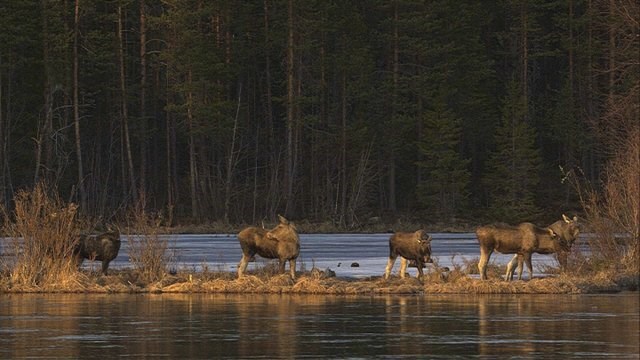
This undated photo, issued by SVT, shows Moose in Junsele, Sweden during preparations for the livestream 'The Great Moose Migration' to document the annual Moose migration near Kullberg in northern Sweden. (SVT via AP)
Republished May 04, 2025 - 1:38 PM
Original Publication Date May 04, 2025 - 4:26 AM
STOCKHOLM (AP) — The seventh season of Swedish slow TV hit “The Great Moose Migration” ended Sunday night after 20 days of 24-hour live coverage.
The show, called “ Den stora älgvandringen ” in Swedish, began in 2019 with nearly a million people watching. In 2024, the production hit 9 million viewers on SVT Play, the streaming platform for national broadcaster SVT.
By 10 p.m. local time (2000GMT) Sunday, the end of the production, the livestream’s remote cameras had captured 70 moose swimming across the Ångerman River, some 300 kilometers (187 miles) northwest of Stockholm, in the annual spring migration toward summer grazing pastures.
The program kicked off April 15, a week ahead of schedule due to warm weather and early moose movement.
Johan Erhag, SVT’s project manager for “The Great Moose Migration,” said this year's crew will have produced 478 hours of footage — "which we are very satisfied with," he wrote in an email to The Associated Press Saturday evening.
Figures for this year's audience were not immediately available, but Erhag said roughly 30% of the viewers tuned in from outside Sweden. The 2025 production attracted international headlines from the New York Times, CNN, Sky News and France 24, among others, following an AP story that published April 15.
“I think AP has been a key for the success around the world this year, absolutely,” Erhag wrote hours before the final footage aired on Sunday night.
The program will return to SVT next spring for its eighth season.
“The Great Moose Migration” is part of a trend that began in 2009 with Norwegian public broadcaster NRK’s minute-by-minute airing of a seven-hour train trip across the southern part of the country.
The slow TV style of programming has spread, with productions in the United Kingdom, China and elsewhere. The central Dutch city of Utrecht, for example, installed a “ fish doorbell ” on a river lock that lets livestream viewers alert authorities to fish being held up as they migrate to spawning grounds.
News from © The Associated Press, 2025